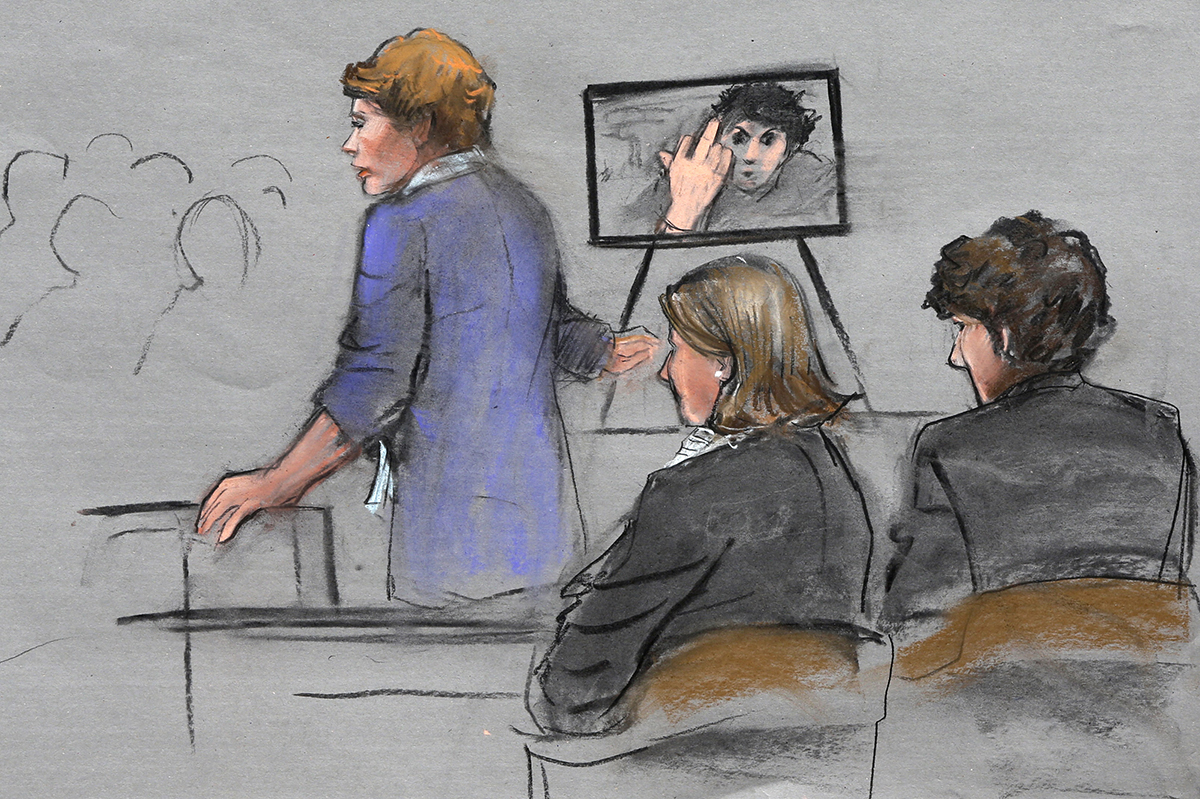Jurors Confront Life and Death as Tsarnaev Trial Reopens

Nadine Pellegrini shows an image of Dzhokhar Tsarnaev from July 2013, three months after the bombings, dressed in prison orange, in a courtroom cell. He’s flipping off the camera. / Courtroom Sketch via AP
“It is impossible for me to overstate the importance of the decision before you,” Judge George O’Toole told the jury this morning as the penalty phase of the Dzhokhar Tsarnaev trial began.
As O’Toole talked the jurors through the death-penalty law, he made it clear they each face a moral question the law alone can’t answer.
“It’s not arithmetic, but an individual juror’s careful, considered judgment,” the judge said. “A decision the law leaves entirely to you.”
Nearly all the jurors, who’d been sitting still throughout O’Toole’s instructions, shifted restlessly when he finished, like they needed a break from the gravity. Soon, each will make their own decision about whether Tsarnaev should live or die. Any one of them can spare Tsarnaev from execution.
Prosecutors placed smiling photos of murder victims Martin Richard, Lingzi Lu, Krystle Campbell, and Sean Collier on easels. Campbell, 29, was shown at a wedding, in a bridesmaid’s dress; Collier also at a wedding, in a suit.
“You know how they died,” prosecutor Nadine Pellegrini told the jury. “Now you need to know how they lived, and understand why their lives mattered.”
To evoke Tsarnaev’s responsibility, Pellegrini quoted Shakespeare: “The fault… is not in our stars, but in ourselves”—and Emerson—“The only person who you are destined to become is the person you decide to be.”
Anticipating the defense’s arguments next week, she asked the jurors not to focus on Tsarnaev’s family background or his brother. “Ask yourself if anything about Tamerlan Tsarnaev explains why Dzhokhar Tsarnaev can take a bomb and plant it behind a row of children.”
As her argument ended, Pellegrini evoked the love and loss of the victims’ families. “It’ll come with a wrenching ache,” she said. “There’s no sense to be made of it. The death was inexplicable, the crimes inexcusable.” Then she showed an image of Tsarnaev from July 2013, three months after the bombings, dressed in prison orange, in a courtroom cell. He’s flipping off the camera.
“This is Dzhokhar Tsarnaev, unconcerned, unrepentant, unchanged,” she said. “Without remorse, he remains untouched, without a grasp of the loss he caused.”
Her argument left several jurors red-eyed and crying. One woman wiped her face and exhaled. Another, fighting back tears, shook her head. One comforted another.
The first witness, Celeste Corcoran, walked to the witness stand on two prosthetic legs, arm in arm with a bailiff. She seemed to whisper, “I can stand,” as she took the oath.
A hairdresser from Lowell, Corcoran recalled walking around Boston with her husband, Kevin, and daughter the morning of the marathon and finding some chairs by the Charles River. “I just put my feet up on the side of the chair,” she said, her voice dropping in sadness, “raising my face to the sun and thinking, ‘It’s such a beautiful day.’”
Corcoran followed her husband to the marathon finish line, hoping to see her sister finish the race. Instead, “I remember being thrown up in the air, or a sensation of kind of flipping around, landing hard, not being able to breathe. I remember this thick, thick, black, heavy smoke. I was choking. I was trying to spit stuff out of my mouth.” She saw blood everywhere, debris falling out of the sky. “I remember lying there as my brain was catching up—‘What was that?’”
Tsarnaev, who sat maybe 15 feet from Corcoran, shifted a little and looked down. Unlike his lawyers, and nearly everyone in the courtroom, he didn’t look at her as she spoke.
Corcoran recalled her husband crouching over her, telling her there’d been a terrorist attack, brushing her hair from her face and reassuring her she was going to live. He tied his belt around one of her legs as a tourniquet, then got another belt from a stranger and did the same.
In the ambulance, her pain was so excruciating that for a moment, she wanted to die—then changed her mind. “I can’t die,” she recalled thinking. “I have to be there for my kids, my husband. I don’t want this to be the end.”
A juror wiped her eyes again. Another juror listened, rapt, her mouth frozen into an O. A third sat stone-faced. A fourth, a young man, leaned back in his chair, his eyes closed. Another juror took notes as Corcoran described the amputation of both her legs, and her injuries to her eardrums and face.
When Corcoran’s testimony ended, and the jurors began to head out of the room, an older man stopped at the edge of the jury box. He turned to watch Corcoran step down from the witness stand and start to walk up the aisle. Corcoran reached the courtroom door and hugged her husband, Kevin. One of them sobbed, and they both shook.


